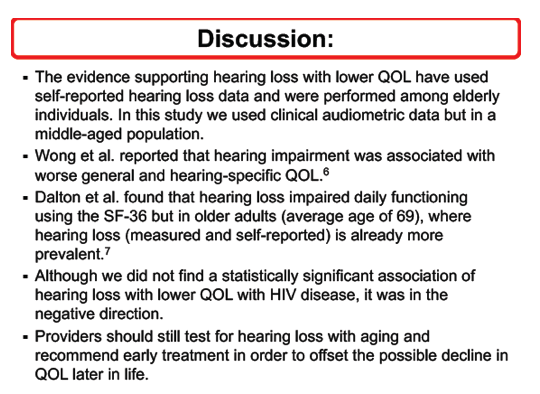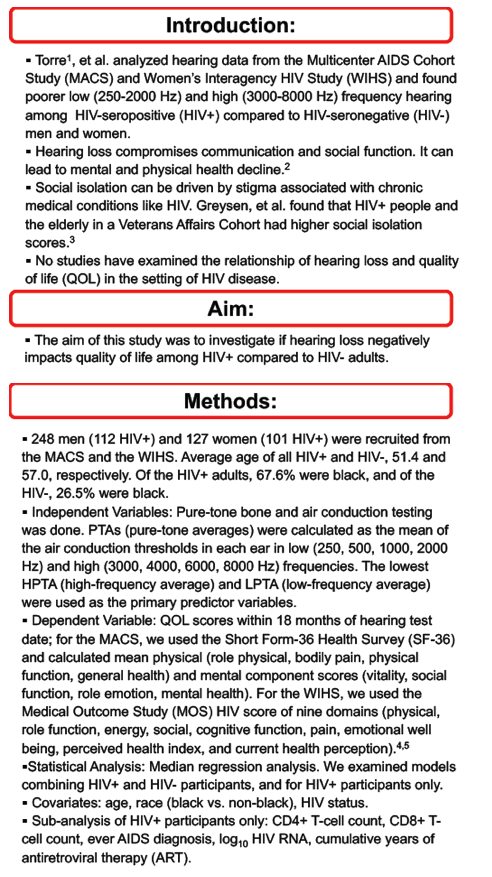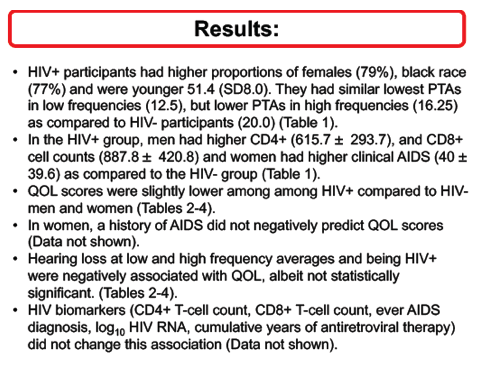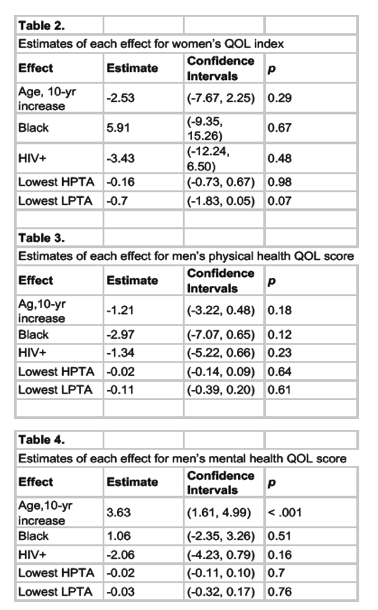 |
 |
 |
| |
Hearing Loss and Quality of Life in Middle-Aged With or Without HIV
|
| |
| |
IDWeek2017/IDSA, October 4-8, 2017, San Diego
Mark Mascolini
Objectively measured hearing loss tended to lower quality of life in HIV-positive and negative men and women in two US cohorts [1]. Although the QOL dip did not reach statistical significance, the researchers advise providers to test for hearing loss in older adults with HIV and to consider early treatment. QOL was always lower in the HIV groups than in the negative groups.
Previous work involving the Multicenter AIDS Cohort Study (MACS) and the Women's Interagency HIV Study (WIHS) documented worse low- and high-frequency hearing in HIV-positive adults than in similar HIV-negative people [2,3]. Hearing loss can lead to declines in mental and physical health, yet no work has assessed the impact of hearing loss on QOL in adults with versus without HIV.
Study participants came from the MACS and WIHS, ongoing observational studies of gay and bisexual men with or at risk for HIV and women with or at risk for HIV. These men and women had their hearing evaluated by pure-tone bone and air-conduction testing. Within 18 months of hearing tests, the researchers evaluated QOL with the Short-Form-36 Health Survey (SF-36) in men and the Medical Outcome Study (MOS) in women.
The study group consisted of 248 men, 112 (45%) with HIV and 136 (55%) without HIV. There were 127 women, 101 (80%) with HIV and 26 (20%) without HIV. Age averaged 51.4 years in the HIV group and 57.0 years in the HIV-negative group. Respective proportions of blacks were 67.6% and 26.5%.
Lowest low pure-tone average measured 12.5 in people with and without HIV, while lowest high pure-tone average was lower in the HIV group (16.25 versus 20.0). Overall QOL scores ran somewhat lower in men and women with HIV than in HIV-negative people (for women median QOL Index 77.68 versus 84.49; for men median mental health scores 53.07 versus 56.40 and median physical health index 51.64 versus 53.17).
Regression analysis adjusted for age, race, and HIV nonsignificantly linked HIV status to lower QOL in women (estimate -3.43, confidence interval [CI] -12.24 to 6.50, P = 0.48). The same analysis nonsignificantly tied HIV status to lower physical QOL in men (estimate -1.34, CI -5.22 to 0.66, P = 0.23) and to lower mental QOL in men (estimate -2.06, CI -4.23 to 0.79, P = 0.16). CD4 count, viral load, an AIDS diagnosis, or years of antiretroviral therapy did not alter these associations.
In the combined HIV-positive and negative groups, there was a trend toward an association between lowest low pure-tone average and lower women's QOL (estimate -0.7, CI -1.83 to 0.05, P = 0.07). But lowest high pure-tone average was not linked to women's QOL. And neither pure-tone average was associated with lower mental or physical QOL in men.
For all men every additional 10 years of age was associated with higher mental QOL (estimate 3.63, CI 1.16 to 4.99, P < 0.001), but a nonsignificant trend ran in the opposite direction for physical QOL (estimate -1.21, CI -3.22 to 0.48, P = 0.18). For all women the association between every additional 10 years and QOL also tended in a negative direction (estimate -2.53, CI -7.67 to 2.25, P = 0.29). Black race was not associated with QOL.
Prior research in the general population tied hearing impairment to worse general and hearing-specific QOL [4] and to impaired daily functioning in older adults (average age 69) [5]. Although the MACS/WIHS study found no significant association between HIV or objectively measured hearing impairment and QOL, the trends detected led researchers to urge providers to test hearing in aging people with HIV and "recommend early treatment in order to offset the possible decline in QOL later in life."
Around the time of IDWeek2017, the San Diego researchers published a comparison of HIV-positive and negative men and women in the MACS and WIHS confirming that the HIV groups had significantly worse lower-frequency and higher-frequency hearing loss, independently of antiretroviral therapy, adherence, or HIV-related disease factors [3]. They noted that high-frequency loss could reflect accelerated age (presbycusis), while low hearing loss in middle age is unexpected. "Because some vowels and consonants have predominantly low-frequency acoustic energy," they wrote, "poor low-frequency hearing may impair communication in HIV+ individuals."
References
1. Duong N, Torre P, Springer G, Cox C, Plankey M. Hearing loss and quality of life among human immunodeficiency virus (HIV)-infected and uninfected adult. IDWeek2017/IDSA. October 4-8, 2017. San Diego. Abstract 564. https://idsa.confex.com/idsa/2017/webprogram/Handout/id5815/POSTER063_564.pdf
2. Torre P 3rd, Hoffman HJ, Springer G, et al. Hearing loss among HIV-seropositive and HIV-seronegative men and women. JAMA Otolaryngol Head Neck Surg. 2015;141:202-210.
3. Torre P III, Hoffman HJ, Springer G, et al. Hearing loss among HIV-seropositive and HIV-seronegative men and women. JAMA Otolaryngol Head Neck Surg. 2015;141:202-210. http://newscenter.sdsu.edu/sdsu_newscenter/news_story.aspx?sid=75372
4. Wong LL, Cheng LK. Quality of life in older Chinese-speaking adults with hearing impairment. Disabil Rehabil. 2012;34:655-664.
5. Dalton DS, Cruickshanks KJ, Klein BE, et al. The impact of hearing loss on quality of life in older adults. Gerontologist. 2003;43:661-668.
-------------------------------
http://www.natap.org/2017/HIV/ooi140119.pdf - MACS/WIHS Study - "Hearing Loss Among
HIV-Seropositive
and HIV-Seronegative Men and Women"
3 studies report Hearing Loss in HIV is Worse and Suggests that Aging Worsens Hearing - (09/01/17)
---------------------------
Hearing Loss and Quality of Life Among HIV-Infected and Uninfected Adults
Nikki Duong1, MD, Peter Torre III,2,PhD, Gayle Springer3, MLA, Christopher Cox3, PhD, Michael Plankey1, PhD
1-Department of Medicine, Georgetown University Medical Center, Washington, D.C.
2-San Diego State University, School of Speech, Language, and Hearing Sciences, San Diego, CA
3-The Johns Hopkins University, Bloomberg School of Public Health, Baltimore, MD

Hearing Loss and Quality of Life Among HIV-Infected and Uninfected Adults
Nikki Duong1, MD, Peter Torre III,2,PhD, Gayle Springer3, MLA, Christopher Cox3, PhD, Michael Plankey1, PhD
1-Department of Medicine, Georgetown University Medical Center, Washington, D.C.
2-San Diego State University, School of Speech, Language, and Hearing Sciences, San Diego, CA
3-The Johns Hopkins University, Bloomberg School of Public Health, Baltimore, MD




1- Torre P, 3rd, Hoffman HJ, Springer G, Cox C, Young MA, et al. (2015) Hearing loss among HIV-seropositive and HIV-seronegative men and women. JAMA Otolaryngol
Head Neck Surg 141: 202-210. http://www.ncbi.nlm.nih.gov/pubmed/25541676
2- Li-Korotky HS (2012) Age-related hearing loss: quality of care for quality of life. Gerontologist 52: 265-271. http://www.ncbi.nlm.nih.gov/pubmed/22383543
3- Greysen SR, Horwitz LI, Covinsky KE, Gordon K, Ohl ME, et al. (2013) Does social isolation predict hospitalization and mortality among HIV+ and uninfected older
veterans? J Am Geriatr Soc 61: 1456-1463. http://www.ncbi.nlm.nih.gov/pubmed/23927911
4- Ware JE, Jr., Kosinski M (2001) SF-36 Physical and Mental Health Summary Scales: A Manual for Users of Version 1. Lincoln, RI: Quality Metric Inc.
5- Erlandson KM, Reynolds SM, Cox C, Palella FJ, Witt MD, et al. (2014) Self-reported body fat change in HIV-infected men is a marker of decline in physical health-related
quality of life with aging, independent of co-morbidity. PLoS One 9: e114166. http://www.ncbi.nlm.nih.gov/pubmed/25436612
6- Wong LL, Cheng LK (2012) Quality of life in older Chinese-speaking adults with hearing impairment. Disabil Rehabil 34: 655-664.
http://www.ncbi.nlm.nih.gov/pubmed/22080747
7- Dalton DS, Cruickshanks KJ, Klein BE, Klein R,
|
| |
|
 |
 |
|
|